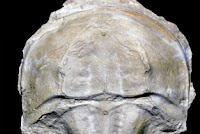The
Eurypterids were a curious group of Chelicerate Arthropods (the group
that also includes Horseshoe Crabs, Trilobites and Arachnids). They
were often formidable in size (the largest were over two meters in
length) had clawed forelimbs and sported a spiked tail, which it has
been suggested may have been use to inject venom (though there is no
evidence of this), which has led to them being given the popular name
'Sea Scorpions' or 'Giant Sea Scorpions'. The group are well recorded
from Silurian and Devonian deposits, where they form a major part of
the fauna of both marine and freshwater ecosystems, but are rarer in
Ordovician deposits. Despite this the group are believed to have
originated and diversified largely within this period, as the group
appears to have divided into numerous lineages prior to becoming
numerous in the fossil record in the Silurian.
In a paper
published in the journal BMC Evolutionary Biology on 1 September 2015,
James Lamsdell of the Department of Geology and Geophysics at Yale University, Derek Briggs of the Department of Geology and Geophysics
and Yale Peabody Museum of Natural History at Yale University,
Huaibao Liu of the Iowa Geological Survey, Brian Witzke of the Departmentof Earth and Environmental Sciences at the University of Iowa, and
Robert McKay, also of the Iowa Geological Survey, describe a new species of
Eurypterid from the Middle Ordovician Winneshiek Lagerstätte of
Winneshiek County in northeastern Iowa.
The
Winneshiek Lagerstätte is a 18-27 m laminated greenish brown and
dark grey shale laid down in a circular depression 5.6 km in
diameter, thought to have been formed by a meteorite impact, the
Decorah Impact Structure. The shale outcrops only at a single
location, but has been found in boreholes across the basin. The
deposits have been interpreted as having formed in a tidal nearshore
environment with low oxygen levels and brackish water in a tropical
climate. The outcrop has produced numerous Arthropods and Conodonts,
Plants, Algae and possible Jawless Fish. From the Conodonts it has
been assigned an age of 467.3-458.4 million years, at least nine
million years older than the oldest Eurytripid-bearing deposits known
from elsewhere, though possible Eurytripids from the Early Ordovician
Fezouata Formation of Morocco are currently under investigation.
Portion of
a Eurypterid from the Middle Ordovician Winneshiek Lagerstätte of
Iowa. Rostrum and linguoid posterior projection underlain by left and
right prosomal appendages II and III. (a) Specimen. (b) Interpretive
drawing: red = ventral plate, green = appendage II, and blue =
appendage III, II-2–II-4 = appendage II podomeres 2–4, III-2 =
appendage III podomere 2. The coxa are angled anteriorly and covered
by the ventral plate, which can be peeled back to reveal their
position. Scale bar is 10 mm. Lamsdell et al.
(2015).
These
deposits produce a large amount of (largely disarticulated)
Eurytperid material, preserved as organic cuticle remains. These have
been reconstructed to construct the complete external morphology of
the living animal, which is formally described and named
Pentecopterus decorahensis,
where 'Pentecopterus'
means 'penteconter-wing', the penteconter being an early Greek
warship with a profile similar to that of the Eurypterid and
'-pterus' (-wing)
being a common suffix for Eurypterid genera, and 'decorahensis'
means 'from Decorah'.
Reconstruction
of Pentecopterus decorahensis
in dorsal view. Scale bar is 10 mm. Lamsdell et al.
(2015).
Pentecopterus
decorahensis is interpreted as
having reached at least 144 mm in length, based upon the reconstruct
specimens. A phylogenetic analysis suggests that it is a member of
the Megalograptidae, a group of mostly large Eurypterids with small
claws, and that within this group it is closest to the common
ancestor of all members. However the Megalograptidae are not
considered to be among the earliest Eurypterids, suggesting that the
origin of the group as a whole occurred considerably earlier than the
Mddle Ordovician.
See
also...
Trilobites dominated the seas of the early Palaeozoic, but suffered
a major loss of diversity in the Devonian...
 Reconstructing extinct Arachnid orders in three-dimensions. There are currently sixteen recognized orders of Arachnids, twelve
of which are extant (have living relatives) and four extinct, the
Trigonotarbids...
Reconstructing extinct Arachnid orders in three-dimensions. There are currently sixteen recognized orders of Arachnids, twelve
of which are extant (have living relatives) and four extinct, the
Trigonotarbids... A new species of Horseshoe Crab from the Late Jurassic Owadów-Brzezinki Lagerstätte of Central Poland. Horseshoe Crabs, Xiphosurida, first appeared in the fossil record
during the Ordovician, at least 480 million years ago, and are still found
today in Southeast...
A new species of Horseshoe Crab from the Late Jurassic Owadów-Brzezinki Lagerstätte of Central Poland. Horseshoe Crabs, Xiphosurida, first appeared in the fossil record
during the Ordovician, at least 480 million years ago, and are still found
today in Southeast...
Follow
Sciency Thoughts on Facebook.



